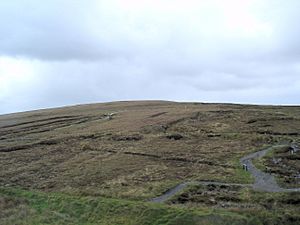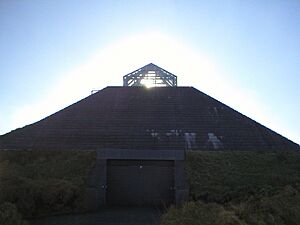Céide Fields facts for kids
Quick facts for kids Céide Fields |
|
|---|---|

Céide Fields in 2007
|
|
| Location | County Mayo, Ireland |
| Built | c. 3500 BC |
The Céide Fields is an amazing archaeological site on the north coast of County Mayo in western Ireland. It's about 4.3 miles (7 km) northwest of Ballycastle. An archaeological site is a place where people find old things from the past.
Many experts say this is the biggest Neolithic (New Stone Age) site in Ireland. It might even have the oldest field systems in the whole world! A field system is a way people organized their farm fields. These fields were built around 3500 BCE (Before the Common Era). That's about 5,500 years ago! Some research suggests they are 3,000 years old, like other Celtic field systems.
Inside the Céide Fields, you can find the Behy court tomb. This is a very old stone monument. The site is also on UNESCO's list of places that might become a World Heritage site. This means it's a very special place that needs to be protected. Scientists believe there are over 60 miles (100 km) of stone walls hidden under the peat bog. A peat bog is a wet, spongy area of land with lots of decaying plants.
Discovering the Ancient Fields
The story of the Céide Fields began in the 1930s. A local schoolteacher named Patrick Caulfield was cutting peat for fuel. Peat is like a natural fuel made from old plants. As he cut, he noticed lines of rocks hidden under the bog.
Patrick thought these rocks looked like they were placed there by people. They didn't seem natural. Since they were under the bog, he knew they had to be very, very old. The bog grew over them a long time ago.
The real mystery started to be solved about 40 years later. Patrick's son, Seamus, became an archaeology expert. He began to look into his father's discovery. Seamus and other archaeologists found a huge network of fields, old houses, and megalithic tombs. These were all hidden by the thick blanket bog that grew over centuries.
Most research by Seamus Caulfield and others points to the fields being from the Neolithic period. This is also called the Stone Age. However, some other studies suggest they might be from a bit later, during the Bronze Age.
Exploring and Protecting the Site
To keep the site safe and learn more, archaeologists used a clever method. They used long, T-shaped iron rods to find the hidden walls under the bog. These rods were already used by local people to find old fallen trees in the bog.
When they dug up areas, they found homes and tombs. These discoveries showed how people lived about 200 generations ago. They were farmers who cleared big areas of forest for their farms. They mostly raised cattle. But they were also skilled craftspeople and builders, working with wood and stone.
These ancient people arrived in a land covered with thick forests. They cut down trees to make space for farming. They also used the wood for building and for fires. Studies show they mostly cleared pine and birch trees. This helped them create pastures for their animals. They kept clearing more and more land for firewood.
The weather back then was much warmer than today. This meant plants could grow almost all year round. Scientists found evidence of this in old tree remains from the bog.
For a while, these farmers did very well. But then, things changed. The climate shifted, and raised bogs started to grow. The good farmland slowly turned into barren land that couldn't be used anymore. An ironpan (a hard layer in the soil) also formed under the Céide Fields.
Seamus Caulfield believes there are still more than 60 miles (100 km) of stone walls hidden under the bog.
More to Explore
- Lynchet
- Kilcommon



